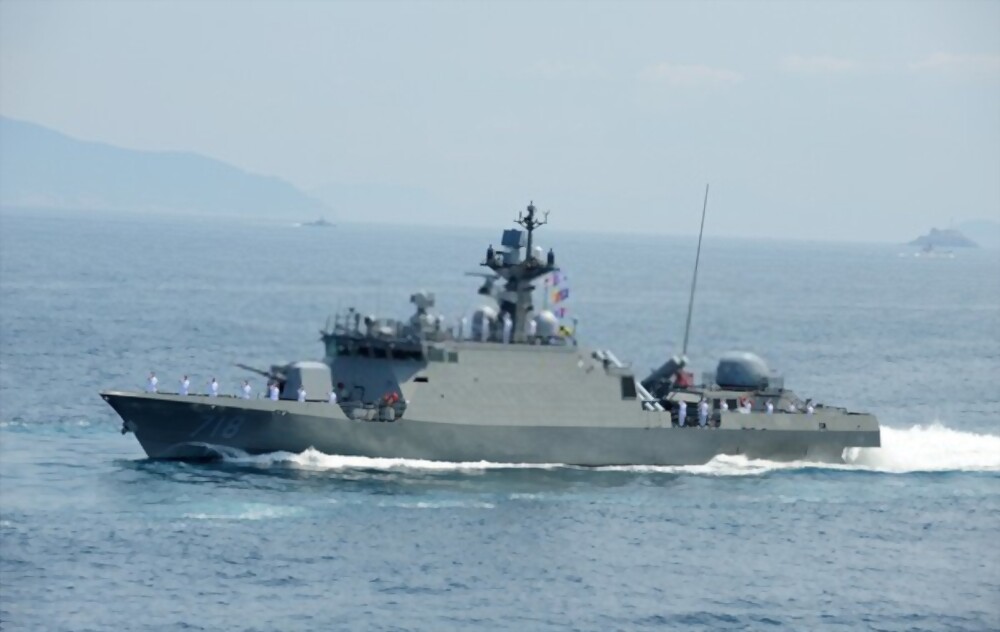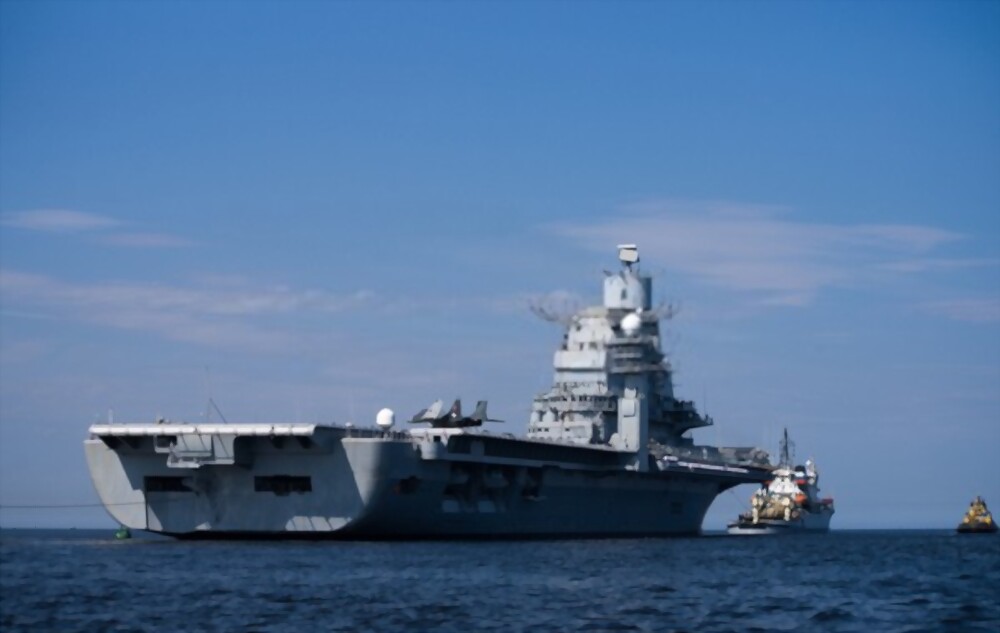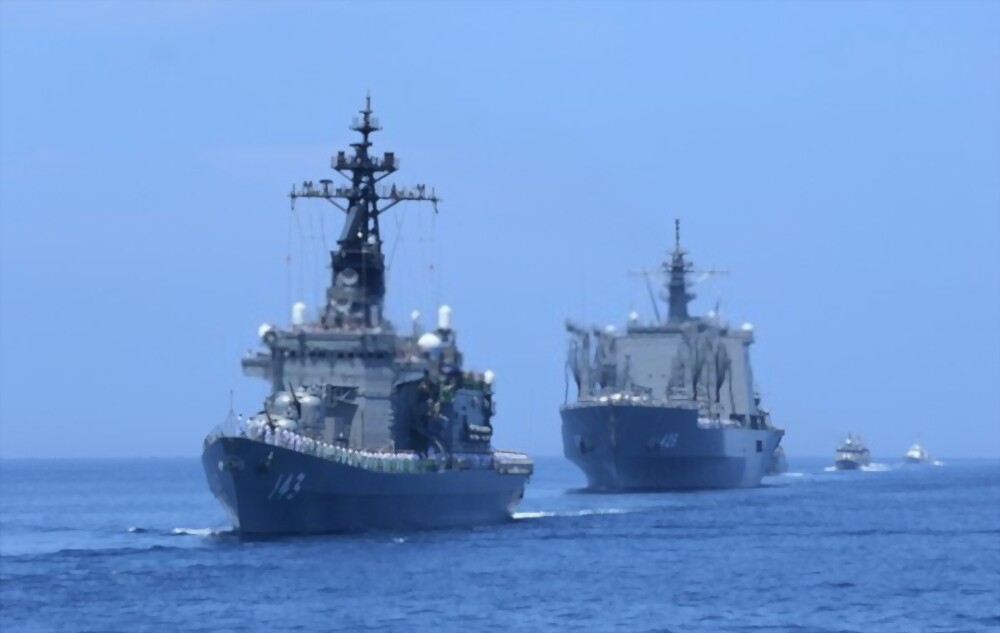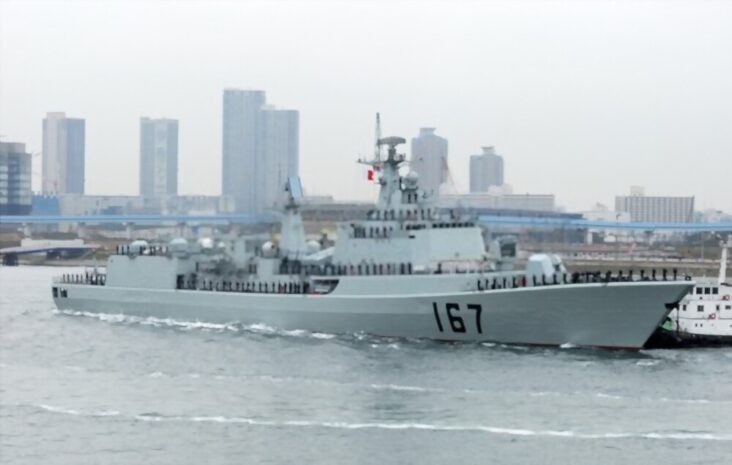The U.S. Department of Defense recently announced that China is currently the biggest Navy in the world. Aren’t you worried about the countries that are behind the Dragon? To be aware of the impact on oceans, especially in light of the current heated geopolitics, it is necessary to look back at the background of the Navy. Since the sea was navigable, the empires from the beginning of time competed to conquer 70% of Earth. The ability of the Navy to project its power across oceans was the basis of global influence. But the question is, what exactly is the role of the Navy? The nation’s Navy recruits and trains then organizes and equips ready maritime forces for combat in order to win potential amphibious and naval conflicts while ensuring the safety of its territorial waters. the country. The listing below was compiled upon data from Global Firepower’s navy ranking 2023 based on the amount of naval offensive and defensive assets that a nation has. The most powerful navies around the world in 2023:
10. Indonesian Navy

- Carriers: 0
- Amphibious warfare ships: 30
- Cruisers: 0
- Destroyers: 0
- Frigates: 7
- Corvettes: 21
- Submarines: 4
It is believed that the Indonesian Navy has the distinction of being the largest Navy of any in Southeast Asia, with approximately 213 different types of ships comprising major surface combatants, 72 coastal and patrol combatants, 11 ships to fight mine warfare, four submersibles, thirty amphibious attack vessels as well as 85 supporting vessels. It has 75,000 active personnel. According to the World Defense and Military Monitor (WDMMW) Global Naval Powers Ranking (2023), Indonesia ranks 10th in terms of the total number of warships and submarines with 221 ships. Modernization in 2023:The Indonesian Navy is upgrading its naval capabilities to better protect its maritime interests and territory. The Minimum Essential Force plan aims to replenish and modernize the fleet, aiming for 151 vessels (minimum), 220 vessels (standard), or 274 vessels (ideal). This includes acquiring small-size, modern frigates, and corvettes equipped with anti-ship missiles, reinforced by many Fast Patrol Boats (FPBs) and guided-missile attack craft. Additionally, Indonesia plans to acquire 12 new diesel-electric submarines. Indonesia’s maritime boundary claims affect its natural resources sector, including fisheries and oil and gas extraction. To enhance its naval capabilities, the Indonesian Navy has been conducting joint military exercises with other countries, such as the United States, to enhance at-sea and amphibious warfare capabilities. However, a lack of resources for national defense is hampering the Navy’s ability to sustain and enhance naval cooperation initiatives. Local southeastern Asian countries broadly welcomed the Indonesian Navy’s expansion plans as a contribution to regional security (to counter its Northern communist threat). The country needs more capacity and capability simply to defend its maritime rights rather than assert itself across the region. While Indonesia has never built a navy strong enough to defend its vast waterways, its current modernization efforts are focused on building a “Green-Water Navy” of 274 ships divided into a “striking force” and a “surface action group.”With the political will and acquisition of powerful combat platforms, such as the two Danish-built Iver Huitfeldt-class frigates currently on order, Indonesia is making progress toward its modernization goals.
9. Italian Navy

- Aircraft carriers: 2
- Amphibious warfare ships: 3
- Cruisers: 0
- Destroyers: 4
- Frigates: 10
- Corvettes: 5
- Nuclear submarine: 0
- Submarines: 6
It is believed that the Italian Navy was known as the Royal Marine before World War II when they were the Republic of Italy replaced the Kingdom of Italy.
Italian Navy (officially Marina Militare Italiana) is a fleet of naval vessels with around 31,000 members in active service.
The Italian Navy has warships of all kinds. They also have an aircraft carrier belonging to the Cavour-Class that is the flagship.
It can handle V/STOL (Harriers and F-35Bs) helicopters, helicopters, as well as aircraft systems. The Cavour is able to transport and hold vehicles and troops as well. A smaller aircraft carrier called Giuseppe Garibaldi is also in service. The fleet comprises two aircraft carriers, six diesel-powered submarines and 3 amphibious assault vessels, 4 destroyers, 10 frigates five corvettes, 10 coastal patrol vessels 10 offshore patrolling vessels four coastal patrol vessels as well as 6 active anti-submarine frigates from the Maestrale class frigate. The Marine Brigade of Italy (San Marco Marine Brigade) is a force of 3,800 soldiers in addition they Navy is the one that recruits amphibious troops aboard three amphibious transport ships of the San Giorgio class. The Navy built it in the hopes of enhancing standards and could be able to increase the number of troops as compared to the third ship in the San Giusto class. Italy is currently working on a new amphibian assault vessel that is based in Trieste. By 2022, it will replace the light aircraft carrier, Giuseppe Garibaldi.
8. Republic of Korea Navy

- Aircraft carriers: 1
- Amphibious warfare ships: 1
- Cruisers: 0
- Destroyers: 12
- Frigates: 14
- Corvettes: 36
- Nuclear submarine: 0
- Submarines: 23
Since the 90s, South Korea has significantly enhanced its naval capabilities to combat China in the region. It is also battling China-North Korea, national security threats that are similar in nature to Taiwan. But in contrast to the Taiwanese Navy which imports numerous ships from countries in the West and other countries, it is the South Korean Navy that operates every vessel built within their homeland. Most of these are manufactured and designed by state-owned companies. Private businesses such as Hyundai and Daewoo are the main producers of the equipped vessels. South Korea is home to 70,000 active personnel. This is larger than the combined forces from our predecessors Italian Navy and the Republic of China (Taiwan). Its navy fleet includes 23 submarines, an amphibious assault vessel, 6 landing vessels, eight landing craft, and 12 destroyers, as well as 34 corvettes, 14 frigates 11 mine countermeasures ships as well as 70 combat aircraft. South Korea requires a strong defense force to ward off its sea-based enemies and threats to the horizon. Thankfully since the end of the Korean War, the South Korean economy has been steadily improving and allowed the government to make use of modern military equipment and not worry about financial constraints. Based on what’s happening within North Korea today, you should expect that South Korea will continue to expand its South Korean government and further improve the nation’s coastal defenses. Considering the North Korean Navy and its fleet, the Korean People’s Army Naval Force currently has the second-largest navy force of its kind in the world. North Korea is home to 967 ships, which include 438 patrol vessels and 86 submarine fleets. There are also 25 mine-war vessels along with the 10 frigates. Although South Korean Marines were founded years ago, they have lately become a mighty sea force and are the eighth-largest Navy in the world.
7. French Navy

- Aircraft carriers: 1
- Amphibious warfare ships: 3
- Cruisers: 0
- Destroyers: 11
- Frigates: 11
- Corvettes: 0
- Nuclear submarine: 10
- Submarines: 0
The French Navy (La Royale) was founded in 1624 under the Kingdom of France and is one of the longest-running military forces. The French Navy served a crucial role in the construction of the French colonial power and helped allies to win both wars. The fleet consists of about 36,000 naval officers who are currently employed and around 200 aircraft that have one carrier, 4 submarines, six attack submarines equipped with combat ballistic missiles, three amphibious warfare ships, four air defense destroyers general-purpose frigates, 6 surveillance frigates 21 patrol vessels along with 18 mine counter-attack warships. The list also includes various vessels supporting and assisting the vessels, such as training vessels tugboats, refueling vessels, and training vessels. France is also among the nuclear powers around the globe which is why it’s not unexpected that there is an extensive battle force along the coastline. As the sixth-highest Navy worldwide It is characterized by its mission of preserving intelligence as well as public safety as well as crisis management and stopping the possibility of invasion. The Marine Nationale comprises four branches.* Force D’Action Navale* Forces Sous-marines* Aeronavale* Fusiliers marine.The Naval Force operates many combat vessels, including nuclear submarines, nuclear carriers, and frigates. Among these is the French Navy’s famous Charles de Gaulle aircraft carrier which is an exclusive type that includes aircraft carriers. New frigates will be ordered for the replacement of destroyers Cassard as well as Georges Leagues. Aquitaine Class frigates.
6. Indian Navy

- Aircraft carriers: 1
- Amphibious warfare ships: 1
- Cruisers: 0
- Destroyers: 11
- Frigates: 14
- Corvettes: 26
- Nuclear submarine: 2
- Submarines: 14
India is gradually but surely increasing its resources for defense, enabling it to become a world sea power. Considering the increasing power of the Chinese neighbor in the Asia Pacific, India and the United States, Japan, and Australia have formed an informal alliance of strategic importance called the Quadrilateral Security Dialogue (Quad).INS Vikramaditya is the mainstay for India’s Indian Navy (modified Kiev-class aircraft carriers). This carrier is not very large in the amount of naval aviation carriers carrying capacity. The state-owned firm Cochin Shipyard built the first home-built plane carrier INS Vikrant, commissioned in 2013 and more robust than its Russian-built predecessor. Both INS Vikrant and INS Vikramaditya have increased India’s power projection capacity across the Indian Ocean. The third, the INS Vishal aircraft carrier (also called”the Indigenous Aircraft Carrier 2) was built and designed in 2013 by Cochin Shipyard for the Indian Navy.INS Vishal will be India’s second aircraft carrier and the first supercarrier.11 destroyers operate in the Indian Navy, including three Kolkata class, three Delhi class, and five older destroyers of the Rajput class. Indian Navy had crafted several modern-day technology vessels and including the three Shivalik as well as six Talwar guided missile frigates. There is also a single frigate from the class of Godavari, three of the older Brahmaputra classes, and 26 corvettes that are designed to safeguard the coastal Waters. Indian Navy will soon operate single ballistic missile-class submarines, and the second-class vessel is scheduled to be launched shortly. These submarines that are nuclear powered have been designed and are incorporated with the highest level of secrecy. Along the diesel-powered submarines, there are also nuclear-powered submarines. Indian Navy has two nuclear-powered submarines. The Indian Navy is modernizing to improve its outdated technology for military use and increase the efficiency of its domestic defense industry. In 2021, Landing Craft Utility (LCU) Mark IV Class was launched in the Navy constructed and designed by the Garden Reach Shipbuilders and Engineers Ltd (GRSE), Kolkata. These vessels serve as the primary means of transporting battle tanks and vehicles, troops, and equipment from the ship to shore. Experts typically view this new technology as a part of India’s defense plans to improve coastal water security and expand its position within and around the Indian Ocean.
5. Royal Navy

- Aircraft carriers: 2
- Amphibious warfare ships: 6
- Cruisers: 0
- Destroyers: 6
- Frigates: 13
- Corvettes: 0
- Nuclear submarine: 11
- Submarines: 0
British Empire The British Empire was once the largest kingdom in all of the globe which controlled the majority of oceans, waters, and territorial waters from the middle of the 18th century through the early twenty-first of the 20th century.
Similarly, the Royal Navy was once the largest navy in the world and has a significant influence today.
It had an unrivaled influence and played a significant role in the creation of a nation. United Kingdom. It was the United States Navy only surpassed it after they declared war on the British Empire after Second World War was over. Speaking about its capabilities today, two Queen Elizabeth class aircraft carriers have been operating since the beginning of the century that includes HMS Queen Elizabeth as the flagship of the fleet ship. British aircraft carriers for naval use are less powerful than American carriers but are more recognizable as compared to Russian as well as Chinese ones. British Navy is home to six destroyers for anti-air combat and they are able to patrol large areas and provide an air defense. In opposition to Daring class destroyers, the 13 Duke frigates are primarily utilized for a variety of roles and anti-submarine warfare. There is a highly respected Royal Marine Commando Brigade of 7,700 people in the Royal Navy. The Royal Marines are Europe’s most powerful naval infantry unit (second to the second largest in the world, second only to that of the US marines corps). Additionally, the Royal Navy has two land vessels in the class Albion and three landing platforms for logistical purposes within the Bay class. Three nuclear-powered submarines are in operation within the Astute class. Three nuclear-powered attacks Trafalgar-class active warships are expected to slowly disband in the next years. British also owns 4 Vanguard ballistic missile subs, as well as Tomahawk cruise missiles that are used by all subs. Each of these vessels can carry up to the equivalent of 192 nuclear warheads. the power of these ships is sufficient to destroy entire nations at once. The fleet consists of one aircraft carrier as well as three missile submarines 6 nuclear-powered submarines three amphibious ships, 6 destroyers 13 frigates as well as three offshore patrol boats thirteen minehunters, and 18 speedy and agile patrol boats. The Royal Navy also uses the HMS Bristol destroyer type 82 as well as the HMS Victory ship of the line. One of the latter is notable because it’s the longest-running naval vessel in service and also serves as the first sea lord’s flagship.
4. Japan Maritime Self-Defense Force

- Aircraft carriers: 0
- Amphibious warfare ships: 7
- Cruisers: 0
- Destroyers: 40
- Frigates: 6
- Corvettes: 0
- Nuclear submarine: 0
- Submarines: 20
Japanese Navy was officially established just a few years following the Second World War after the Imperial Japanese Navy was dissolved. Japan the Maritime Self-Defense Force (JMSDF) is the maritime warfare arm within the Japan Self-Defense Forces comprised of 50,800 soldiers 150 ships and nearly 350 aircraft. The Japan Self-Defense Maritime Force includes seven warships, 40 destroyers, six frigates four air defense destroyers three landing vessels as well as two landing craft 25 counter-attack vessels, and six patrol vessels along with eight training boats. Japan has recently upgraded its marine facilities, similar to South Korea, to defend itself from North Korean, Chinese, and Russian threats. Recently Japan, Taiwan, as well as the US, have formed a trilateral agreement to thwart China’s fleet that is powerful throughout and around the South China Sea and overall the Western Pacific. The Japan Sea Forces is a Japanese self-defense military unit that is responsible for the country’s coastal defenses. Their military expansion is legalized to the military doctrine that is an element in the Japanese constitution. It has modern submarines and warships. However, they also ensure that the Japanese fleet is well-equipped and efficient. Therefore when Japanese navy units lost total numbers as well as tonnage (total Million tonnes) in the hands of China, Chinese vessels, and Japanese warships were more modern and equipped with the latest arms. The JMSDF has no nuclear power-powered attack submarines, however, it has about 20 submarines. As Japan is not using nuclear warships. However, it has built diesel submarines, which have increased their strength in offensive capabilities. Yet Japan does not have any submarine ballistic missiles and strategically-focused ballistic missiles. Naval aircraft in Japan include around 70 Lockheed P-3C orions and twelve Kawasaki Navy P-1s.
3. Russian Navy

- Aircraft carriers: 1
- Amphibious warfare ships: 52
- Cruisers: 6
- Destroyers: 18
- Frigates: 6
- Corvettes: 78
- Nuclear submarine: 59
- Submarines: 0
After the success of the Red Fleet, the Russian Navy was officially launched in 1992 after the end of the Soviet Union. It has around 148,000 personnel in active service and more than 300 operating vessels as well as 300 boats, nearly three times the size of Japan Maritime Self Defense Force’s active staff. Russia’s navy fleet comprises the cargo ship a battlecruiser, 3 cruisers and 13 destroyers eight frigates and 78 corvettes 17 submerged SSNs 22 submarines and 13 submarines designed for ballistic weapons, seven submarines designed for cruise missiles and three submarines with special purposes. The Russian Navy inherited the fleet of the Soviet Navy following the collapse of the USSR. The Soviet fleet has decreased significantly since the beginning of the 1990s due to the conclusion of the Cold War and the resulting funding problems. Cold War remnants comprise the majority of the vessels. Over the past two years it has been a struggle for the Russian defense has been struggling with keeping its main forces in good order because of its low funding. Three small missile Slava class cruisers provide excellent anti-aircraft, anti-ship (guided-missile destroyer), and combatant submarine capabilities. While Russia is better known for its powerful military forces on the ground (military) but its Navy wasn’t as effective as its western counterparts. But the times have changed with the advent of the modern Russian Navy shows that Russia is prepared for sea combat which makes it an extremely powerful force. Still, there is a gap in the Russian Navy that is lagging in comparison to the Chinese Navy (on paper) in terms of the number of warships as well as tonnage. Russia is however home to many ballistic missile submarines with proven capabilities that have proven to be extremely deadly. It remains its most potent submarine worldwide it is the Typhoon-class submarine.
2. United States Navy

- Aircraft carriers: 11
- Amphibious warfare ships: 34
- Cruisers: 22
- Destroyers: 69
- Frigates: 21
- Corvettes: 27
- Nuclear submarine: 70
- Submarines: 0
In comparison to the Chinese navy, the Chinese navy holds an advantage numerically in terms of a total naval fleet, however, the US remains the most powerful navy in the world due to its technical edge. The US shifted its naval functions from a possibility of direct conflict between Russia and the Soviet Union to regional conflicts during the 1990s in the wake of the Cold War. The lack of funding and the absence of sufficient threats, however, primarily due because of the expense of smaller vessels, US fleets continue to decline. At the beginning of the 20th century, the US gained control of the British empire with its naval strength. Thanks to one of the greatest leaders, Theodore Roosevelt, who used his Big Stick ideology. It is the US Navy operates 11 large aircraft carriers equipped with five-generation technology jets. There is a total of 21 Commissioned carriers that range from Nimitz through Gerald R. Ford Class, the biggest aircraft carrier, as well as 3 Tarawa class carriers in reserve. They are able to operate fixed-wing aircraft, as well as helicopters, and have nuclear power. Each carrier is able to carry up to 70 attack fighter jets, or swift aircraft to conduct surveillance.
By law, the American Navy must operate a minimum of 11 aircraft carriers (excluding helicopter carriers). American Class Amphibious Assault Ships and Wasp Class Amphibious Assault Ships are some of the best warships in the world. Each of these warships carries a force of approximately 1700-2000 Marines and blinded vehicles and delivers tilt rotors, helicopters, and hovercraft to shore.US Navy’s USS Zumwalt (DDG 1000) is the largest and most technologically advanced surface combatant with the most powerful guided missile destroyers in the world ever built. Before joining the Pacific Fleet, this 610-foot long, 15,000-ton behemoth started sea trials in 2015. The Arleigh Burke-class destroyers were designed as multi-mission destroyers. Capable of launching long-range Tomahawk missiles strategically on land, anti-aircraft warfare (AAW) with powerful Aegis radar, and Surface-to-Air Missiles. You might wonder how many ships are in the US navy. According to the Naval Vessel Register and published reports, the United States Navy has over 490 ships in both active and reserve operations.Nuclear-powered attack submarines patrol waters near the United States or far away from the seas, making effective anti-submarine efforts useless. Nearly 3,700 planes serve the US Navy. Built on aircraft carriers The majority of them are multi-role fighters from the F/A-18 family, as well as other aircraft that are associated with them. (Fun fact: Technically speaking this US Navy is the second-largest air force after its US Airforce if we look at the total number of fighter aircraft and attack helicopters in the US Navy). It will likely remain on top of the list for the near future, based on the amount that the US government is spending on military equipment.
1. People’s Liberation Army Navy

- Aircraft carriers: 2
- Amphibious warfare ships: 69
- Cruisers: 0
- Destroyers: 36
- Frigates: 52
- Corvettes: 42
- Nuclear submarine: 14
- Submarines: 45
According to a recent U.S. defense report, China currently has the largest Navy worldwide as of 2022 when it comes to its navy fleet. The People’s Republic of China’s navy is growing rapidly with regard to its weapons of attack, creating new submarines and warships, and building new ships more quickly than ever. The Chinese Navy, officially known as The People’s Liberation Army Navy, has an estimated strength of 255,000 active personnel. China’s naval power is managed by the three Northern, Eastern, and Southern theaters, each with its individual headquarters located situated in Qingdao, Ningbo, and Zhanjiang. The Chinese Navy owns a single Liaoning aircraft carrier, which was launched in the year 2018 and is used mostly as an exercise ship. But these modern warships are not as effective in comparison to their Western and Russian counterparts. On the contrary, the development of new warships that are advanced is increasing rapidly, bolstering the Chinese military. Chinese military. People’s Liberation Army Navy (PLAN) is home to 350 battle force vessels, contrary to U.S. Navy’s 293 ships. It is anticipated that around 5 to six guidance missile cruisers of Type 055 destroyers are expected to be finished by the end of this year. People’s Liberation Army Navy quickly emerged as one of the most powerful maritime forces.


GIPHY App Key not set. Please check settings